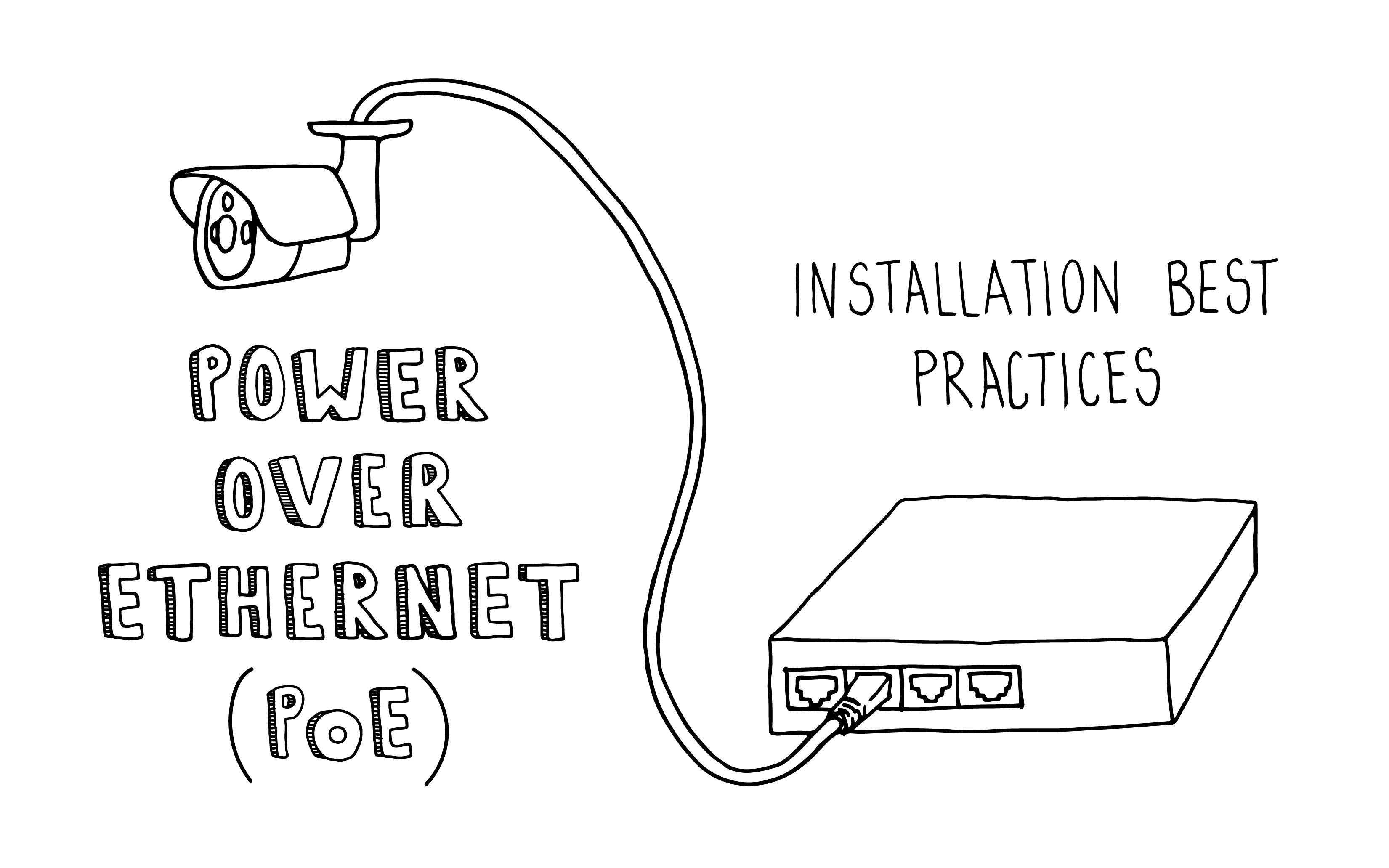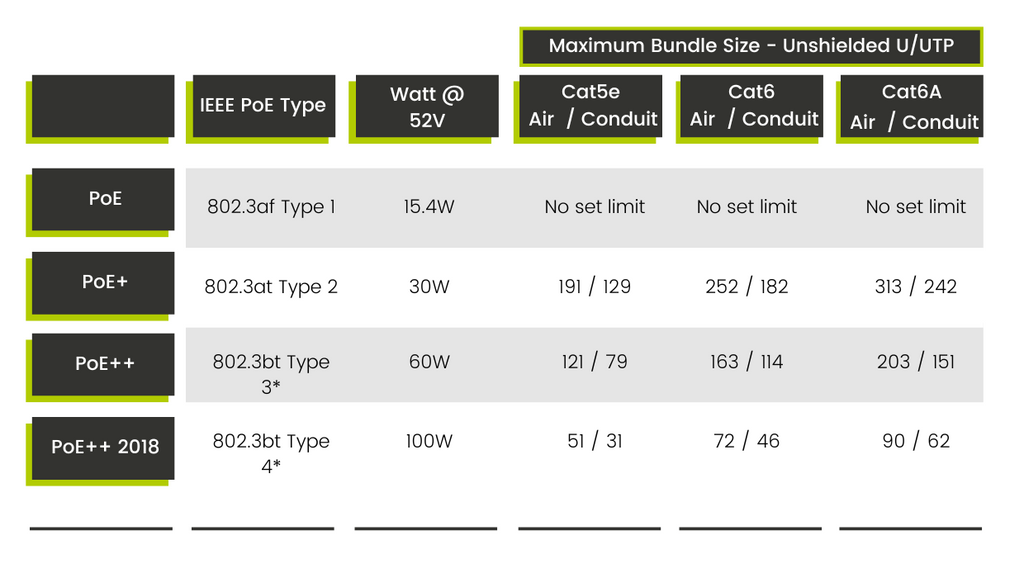

You just bought a nice PoE (Power over Ethernet) switch with cameras and access points. You realize you need to buy Ethernet cable to handle this, but you are a bit worried about which cable is the right kind and if there are any special techniques you should use. Not to mention, how about accessories? You start looking through products and documentation out there and get a lot of conflicting information along with answers to questions you don’t fully understand. This can end in a great deal of frustration.
There is a great deal of conflicting information online since there have been 20+ years of answers that have evolved over time. An answer that was correct 10 years ago may not be quite as accurate (or completely inaccurate) as it is today. trueCABLE has done a great deal via education content in our Cable Academy to reduce this confusion and bring concrete answers to your questions. In this blog, we will clear up one of the most confusing things for the average installer and/or homeowner: PoE.
First, let’s talk a bit about what PoE is. One of the biggest advantages of copper twisted pair Ethernet cable (also called Category cable) is it’s ability to perform two critical functions at the same time:
When these functions are simultaneously performed, it is known as PoE or Power over Ethernet. A single cable is used to do it, which means you don’t need to find an AC power outlet near your end point device. Metallic Ethernet cable is the only choice for this as fiber optic cable , also capable of carrying Ethernet packets, is unable to transmit electricity since it makes use of light pulses over glass. For those not in the know, glass is quite horrible at transmitting electricity! Power over Ethernet, therefore, will be with us for some time to come and it will actually get even more pervasive as we automate our lives.
PoE is not new, but it certainly is being used in new ways and is being called upon to power up devices you may not be aware of. Common uses for PoE include:
Take all of those devices and hook them into the same Ethernet network and now you have something you can centrally manage with nothing more than an app on your smartphone. Pretty cool, huh? For a more detailed look at the technology behind PoE see The Power of PoE .
One item of great importance is there is NO RISK of a fire or personal injury, even in the most extreme circumstances, assuming CCA (Copper Clad Aluminum) is not used and we are talking about an industry recognized style of PoE as defined by IEEE (not some manufacturer’s specific version). For more on why you should never (ever) use CCA please see Copper Clad Aluminum vs Copper: The Ultimate Test on a Fluke Versiv DSX CableAnalyzer.
Although a great deal has been written about the types of PoE out there, very little is devoted to the best way to install the physical cable so you don’t run into any issues with performance. Remember, although PoE is considered low voltage it is still voltage with wattage and those requirements are increasing, not decreasing. With that being said, heat may become an issue! We are going to cover:
On the outside most Ethernet cable looks the same. Cut it open and you start to find the differences. Some differences matter more than others. Here are some generalizations:
The above generalizations need to be taken in context, however. That context is the specific application and installation, and usually no two are precisely alike. This is one of the reasons why there is a great deal of conflicting and misinformation out there about PoE. Combine this with “closely held beliefs” and other anecdotal advice and you can start to see the problem.
One of my favorite sayings regarding the technicalities of Ethernet cable installations is “usually, but not always”. What I mean is that the answers are often not concrete and vary by your installation and your goals. There can be more than one correct answer. Some answers are more correct than others.
Interestingly, within a certain boundary of guidelines, the issue of Ethernet cable type has more to do with the specific installations than the actual Category or construction of the cable.
As for termination accessories, all of trueCABLE’s Ethernet keystone jacks , field termination plugs , Ethernet couplers , and RJ45 8P8C connectors handle Type 4 Class 8 IEEE 802.3bt, PoE++ up to 100W with no issue. As it turns out, the limiting factor on PoE ratings for accessories has to do with a phenomenon known as “spark arc damage”. This happens by plugging and unplugging live PoE circuits.

Before and after results of unplugging a live PoE circuit. This damage does accumulate!
Each time you plug and unplug a live PoE connection, a tiny spark is created. Over time it will accumulate in the form of minute pitting and burns on the surfaces of RJ45 8P8C contact wires and the associated contact springs inside keystone jacks or couplers. Accumulation of this (not always visible) damage will contribute to performance degradation and possible termination hardware damage. Note, we are not talking about a few plugs and unplugs. We are talking about hundreds. In other words, this is not a huge worry but we will address that later too as the problem can be avoided.

* Type 3 and Type 4 are also known as 4PPoE or 4 Pair PoE. Type 2 PoE is 2 Pair PoE.
Notes for using this table:
Here’s a pro tip (and shortcut!). If you base all of your maximum run lengths off of the guidelines found in Temperature's Effect on Ethernet Cable Length and then secondarily use the table above for bundle sizes you are good to go for the worst case scenario!
WAIT, THERE’S MORE! If you base your bundle size and run lengths using the above tip and then combine that with Conduit Fill Chart for Ethernet and Coaxial Cable for installations requiring conduit, you get a FREE set of steak knives! Well, not really, but you will be operating like a master chef. Proper Ethernet cable installations are a balancing act of multiple factors taken into account.
Do NOT:
As luck would have it, the vast majority of Ethernet switches and patch panels come in rows of 24. Although you may be dealing with a 48 port PoE switch or 48 port patch panel, it will be two rows of 24. Well, it turns out that 24 is below the absolute worst case scenario of 31 Cat5e cables bundled into a conduit when running at 100W on 802.3bt PoE++.
Simply keep any bundle to 24 or less and then keep those bundles separated by 1.5” and at no point will you ever run into a problem. For commercial installations, the side benefit is any code inspector coming out to inspect your work will have a much easier time figuring out what you have done and you will be able to pass code inspection easily--and that will save you time and hassle. Yes, the NEC does indeed address PoE now, therefore your inspector can hold you to it. Avoid trouble and lots of extra explanations with this strategy!
And there you have it. The average DIY installer and/or homeowner is not likely to bump into the maximum worst case scenarios outlined in this blog, but PoE is becoming more and more important to IoT and smart devices designed to save energy and provide convenience. It is best practice to follow these guidelines for any installation as you never know what the future will bring. With that I will say…
trueCABLE presents the information on our website, including the “Cable Academy” blog and live chat support, as a service to our customers and other visitors to our website subject to our website terms and conditions. While the information on this website is about data networking and electrical issues, it is not professional advice and any reliance on such material is at your own risk.